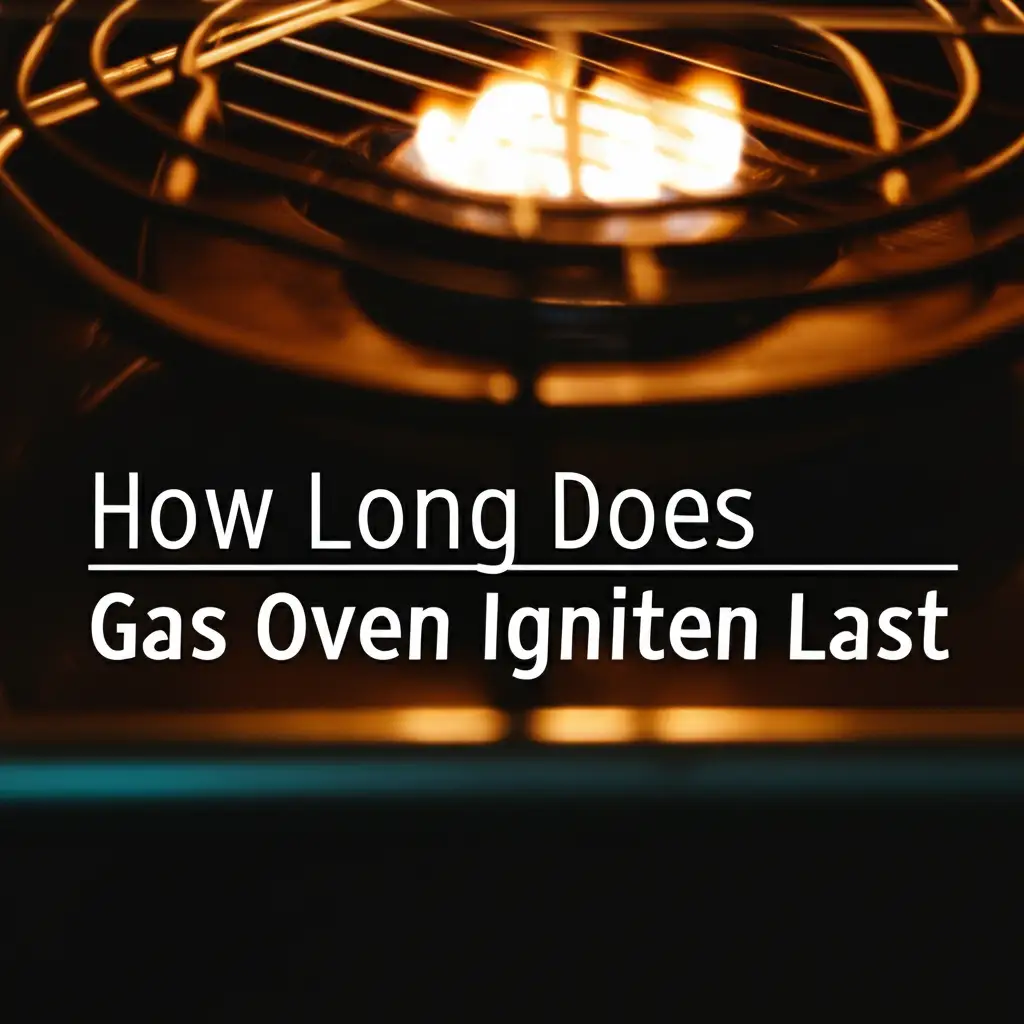· Todd Martin · Kitchen Care · 17 min read
How Long Does Gas Oven Igniter Last

Gas Oven Igniter Lifespan: What to Expect
My oven is a vital part of my kitchen. It bakes cookies and roasts chicken. When it does not heat up properly, cooking becomes impossible. A common culprit for these problems is the gas oven igniter. This small but mighty component is essential for your oven to work.
Many people wonder, “How long does gas oven igniter last?” Understanding its typical lifespan helps you plan for maintenance. It also prepares you for replacement. This article will explore what an igniter is. We will discuss how long it usually lasts. We will also cover signs of wear and ways to extend its life. Prepare to keep your gas oven running smoothly for years.
Takeaway
- Gas oven igniters typically last between 5 to 10 years.
- Factors like usage, oven model, and maintenance impact longevity.
- Signs of failure include slow heating, no flame, or clicking sounds.
- Regular cleaning and proper handling can extend the igniter’s life.
- Replacement is often necessary when the igniter weakens or fails completely.
A gas oven igniter generally lasts about 5 to 10 years. Its exact lifespan depends on how often you use your oven. It also depends on the specific igniter model. Proper care and avoiding damage can help it last longer. Replacing it becomes necessary when it no longer generates enough heat to light the gas.
What is a Gas Oven Igniter and How Does It Work?
My gas oven relies on a special part called an igniter. This component is crucial for starting the flame that heats your food. It does more than just create a spark. The igniter actually serves two important functions. First, it gets hot enough to ignite the gas. Second, it acts as a safety device.
Most gas ovens use a hot surface igniter. This igniter is made of silicon carbide. When you turn on your oven, electricity flows through the igniter. It starts to glow bright orange. This glowing part reaches a very high temperature. This high heat ignites the gas. It also acts as a flame sensor.
The igniter senses if the gas has ignited. It signals the gas valve to open fully only when it detects enough heat. If the igniter does not get hot enough, the gas valve will not open. This safety feature prevents gas from filling your kitchen without a flame. This process ensures your oven lights safely every time you use it. When an igniter glows but no flame appears, it often means the igniter is too weak to open the gas valve. You can learn more about this common problem if your gas oven igniter glows but no flame.
Average Lifespan of a Gas Oven Igniter
Understanding how long a gas oven igniter lasts helps you anticipate potential issues. Most gas oven igniters last between 5 to 10 years. This range is a general estimate. Some igniters might fail sooner. Others could last for 15 years or more. Several things affect this lifespan.
The frequency of oven use is a major factor. An oven used daily will wear out its igniter faster. An oven used only a few times a week will see its igniter last much longer. The quality of the igniter also matters. Original manufacturer parts often last longer than aftermarket ones. Different brands and models of ovens may also have igniters with varying durability.
Over time, igniters degrade because of constant heating and cooling. They are made of a brittle material. Small cracks can form with each use. Eventually, these cracks make the igniter unable to reach the necessary temperature. This leads to slow preheating or no ignition at all. Knowing this average lifespan helps me understand when to start watching for warning signs. If your oven is taking longer to heat, a weak igniter might be the cause. You can find more information about why your gas oven takes so long to preheat.
Signs Your Gas Oven Igniter is Failing
Identifying a failing igniter early can save you frustration. There are several clear signs that your gas oven igniter is nearing the end of its life. These symptoms often develop gradually. Paying attention to them helps you plan for repair or replacement.
One common sign is a slow preheat time. If your oven takes much longer than usual to reach the set temperature, the igniter may be weakening. It might glow, but not hot enough to open the gas valve quickly. I remember my oven used to preheat in 10 minutes. When it started taking 20 or 30 minutes, I knew something was wrong. This often means the igniter cannot achieve the necessary temperature efficiently.
Another clear sign is the oven failing to light completely. You might hear a clicking sound but no flame appears. Or, the igniter glows, but the gas does not ignite. The igniter might be glowing a dull orange instead of a bright, vibrant orange. A bright glow indicates proper function. A dim glow means it is failing. If your gas oven goes out frequently or turns off by itself, a faulty igniter could also be the reason.
Finally, if your oven only works sometimes, the igniter is a likely suspect. It might light on the first try one day and then fail for several attempts the next. This intermittent function points to a tired igniter that struggles to perform consistently. These signs suggest it is time to consider replacement.
- Slow Preheat: Oven takes much longer than normal to reach desired temperature.
- No Flame/No Ignition: You hear gas but no flame, or the igniter glows but the burner does not light.
- Dull Glow: The igniter glows orange, but it is not bright enough. A healthy igniter glows a vibrant, strong orange.
- Intermittent Operation: The oven lights sometimes but not always.
- Gas Smell Without Ignition: If you smell gas but the oven does not light quickly, turn it off immediately. This indicates a serious igniter failure and a potential gas leak.
Factors That Influence Igniter Longevity
Many things affect how long your gas oven igniter will last. Knowing these factors can help you understand why some igniters last longer than others. It also guides you in making choices that might extend its life. Every igniter eventually wears out, but some conditions speed up that process.
First, how often you use your oven significantly impacts its lifespan. Each time you turn on the oven, the igniter heats up and cools down. This thermal cycling puts stress on the igniter’s brittle material. An oven used several times a day will likely need a new igniter sooner. An oven used only for holiday baking might have its igniter last much longer. My family loves to bake, so my igniter gets a lot of use.
Second, power surges or unstable electricity can damage an igniter. Igniters are sensitive to electrical fluctuations. A sudden spike or dip in voltage can weaken or crack the heating element. While these events are often out of your control, they can shorten the igniter’s life. Consider using a surge protector if your home experiences frequent power issues.
Third, grease buildup and food spills can reduce the igniter’s efficiency. While the igniter itself is sealed, a dirty environment around it can contribute to premature failure. Regular cleaning of your oven helps maintain overall appliance health. If you are cleaning your oven, you might want to learn how to clean your gas oven properly. This keeps the igniter area free from debris. A clean area ensures proper air flow around the igniter. This helps it dissipate heat correctly.
Finally, the quality of the igniter itself matters. Cheaper, generic igniters might not last as long as original equipment manufacturer (OEM) parts. OEM igniters are designed specifically for your oven model. They often use higher-quality materials. When replacing an igniter, investing in a good quality part can prevent future headaches.
Extending the Life of Your Gas Oven Igniter
While you cannot make an igniter last forever, you can take steps to extend its life. These simple practices can help your igniter perform well for as long as possible. Good maintenance habits contribute to the overall health of your oven. This in turn makes your appliance more durable.
First, avoid putting excessive strain on your oven. Do not leave the oven door open for long periods while it is heating. This makes the igniter work harder to maintain temperature. It constantly tries to reignite or keep the gas flowing. Opening the door too often also wastes energy. It also adds unnecessary wear to the igniter. Try to gather all ingredients before you start cooking. This way, you minimize how long the door stays open.
Second, keep your oven clean. Grease and food debris can accumulate around the igniter. This buildup can insulate the igniter. This forces it to work harder to reach the proper temperature. A dirty igniter might also experience uneven heating. This can lead to cracks. Regular cleaning of the oven interior is important. This ensures clear space around the igniter and burner assembly. You might consider cleaning the igniter itself if it looks dirty. Learn how to clean an igniter on a gas stove safely.
Third, handle the igniter with extreme care if you ever access it. Igniters are very fragile. The silicon carbide material is brittle. Even a slight bump or drop can cause it to crack or break. If you are replacing other oven parts, be mindful of the igniter’s location. Avoid touching the glowing part directly. Use gloves if you need to handle it. This delicate nature is why professional installation is often recommended for igniter replacement.
Lastly, ensure your oven has proper ventilation. A well-ventilated kitchen prevents heat buildup around the appliance. This can help keep the igniter from overheating unnecessarily. Make sure the oven’s vents are not blocked. These small habits can make a big difference in how long your igniter continues to provide a reliable flame.
When to Replace Your Gas Oven Igniter
Knowing when to replace your gas oven igniter is key to maintaining a functional oven. Delaying replacement can lead to frustrating cooking experiences. It can also cause safety concerns. My personal rule is, if it shows consistent signs of failure, it is time. Do not wait for it to stop working completely.
The most obvious time for replacement is when the oven fails to light at all. If the igniter glows, but the gas does not ignite, it is too weak. The gas valve needs a certain amount of heat from the igniter to open. A dim or slow-to-glow igniter cannot provide this heat. This means no flame. This situation makes your oven unusable.
Another clear sign is constant short cycling. This means the oven lights, but then the flame goes out quickly. Then it tries to relight again. This indicates the igniter is not maintaining enough heat to keep the gas valve open. This can also be a reason why your gas oven only works sometimes. This issue not only ruins your cooking, but it can also be a fire hazard if gas builds up.
Consider replacement if preheating times are consistently very long. If your oven takes twice as long to preheat, the igniter is probably failing. While it might still eventually light the gas, its efficiency is severely compromised. This leads to wasted energy and delayed meal preparation.
Replacing an igniter can be a DIY task for some. It requires basic tools and electrical knowledge. However, if you are not comfortable working with gas lines and electrical components, call a professional. Safety always comes first. If you have a GE XL44 gas oven, you can check out a specific guide on how to replace the igniter on a GE XL44 gas oven. This guide provides detailed steps. A professional ensures proper installation and safety checks.
Troubleshooting Common Igniter Issues
Sometimes, a gas oven igniter acts up without completely failing. Understanding common issues can help you decide if it’s time for a full replacement or if there’s a simpler fix. Most problems relate to the igniter’s ability to get hot enough or signal the gas valve.
A frequent issue is the igniter glowing but no flame appearing. I have experienced this several times. When this happens, the igniter is getting power and heating up. However, it is not reaching the critical temperature needed to open the gas safety valve. The valve requires a specific amount of heat to release the gas. If the igniter is weak, it glows dull orange. This dull glow is not enough. The igniter needs replacement in this scenario. This specific problem is so common there’s a dedicated resource for why a gas oven igniter glows but no flame.
Another common complaint is the oven taking too long to preheat. This directly relates to the igniter’s efficiency. A strong igniter quickly reaches optimal temperature. It opens the gas valve fast. A weakening igniter takes much longer to achieve this. This means the burner gets gas later. The oven therefore takes more time to heat up. While other factors can affect preheat time, a slow igniter is a primary suspect.
Sometimes, the oven might click repeatedly without lighting. This indicates the spark igniter is trying to light the gas but fails. This is less common for oven igniters (more for stovetops), but if your oven exhibits this, it means the igniter is not converting the gas into a flame. It might be dirty or faulty.
Before replacing, check simple things. Ensure the oven is plugged in. Check the circuit breaker. Sometimes, a power interruption can cause temporary issues. However, if the igniter consistently struggles to light the gas or takes forever to preheat, replacement is the most likely solution. Do not attempt complex repairs unless you are a qualified technician. Safety is paramount when dealing with gas appliances.
Types of Gas Oven Igniters and Their Durability
Not all gas oven igniters are the same. Understanding the different types helps explain variations in durability and common failure modes. The two main types are hot surface igniters and spark igniters. Most modern gas ovens use hot surface igniters.
Hot surface igniters are the most common in ovens today. They are typically made of silicon carbide. This material heats up to a very high temperature. This heat ignites the gas. It also acts as a sensor to keep the gas valve open. Their durability comes from consistent performance. However, they are also quite fragile. They can crack or become weak over time due to repeated heating and cooling cycles. This thermal stress is the primary reason for their failure. They typically last 5 to 10 years, as discussed. Their failure usually manifests as a dull glow or no glow at all. This means they cannot reach the ignition temperature.
Spark igniters are less common in modern oven burner systems. You see them more often on gas stove burners. They create a visible spark that lights the gas. These igniters are generally more durable mechanically. They do not get hot to ignite the gas. They only create a momentary spark. This means less thermal stress. However, their lifespan can be affected by dirt, grease, or damage to the ceramic insulator. If a spark igniter fails, you might hear a clicking sound but see no spark. Or, the spark might be too weak to ignite the gas. While spark igniters can last longer, their application in oven main burners is limited due to safety regulations requiring flame sensing.
Regardless of type, all igniters face wear and tear. Hot surface igniters wear out from internal degradation due to heat cycles. Spark igniters wear out from physical damage or carbon buildup. Knowing your oven’s igniter type helps you understand its specific failure characteristics. It also helps in choosing the correct replacement part. Always consult your oven’s manual to identify the exact type of igniter your model uses. This ensures you get the right part for a replacement.
The Importance of Professional Installation vs. DIY
When your gas oven igniter fails, you face a choice: replace it yourself or hire a professional. Both options have pros and cons. My advice is to always prioritize safety. Working with gas appliances carries inherent risks.
DIY replacement can save you money on labor costs. Many igniter replacements involve basic tools. You might find several online tutorials. If you are comfortable with basic electrical work and following instructions precisely, it is possible. However, you must turn off the gas supply and electrical power. You must also handle the fragile igniter carefully. Incorrect installation can lead to gas leaks or electrical shorts. These are serious safety hazards. If you are not completely confident in your abilities, do not attempt it.
Hiring a professional appliance technician offers peace of mind. Professionals have the right tools and experience. They know how to safely disconnect gas lines and electrical components. They can diagnose if the igniter is truly the problem or if another issue exists. They also ensure the new igniter is installed correctly. A professional can test for gas leaks after installation. This is a critical safety step. While it costs more, the safety and assurance are often worth the expense.
For me, if it involves gas, I usually call a professional. The risk of a gas leak or fire is too high. A professional can spot other potential problems too. They can ensure your oven operates safely and efficiently. Always weigh the cost savings against the potential risks. When in doubt, call a certified technician. Your family’s safety is the most important consideration.
FAQ Section
How often should I replace my gas oven igniter?
You should replace your gas oven igniter when it shows clear signs of failure. This usually happens between 5 to 10 years of use. Symptoms include slow preheating, the igniter glowing but no flame appearing, or intermittent oven operation. Do not wait for it to stop working completely.
Can a bad igniter cause my oven to not heat properly?
Yes, absolutely. A weakening or failing igniter is a common reason for an oven not heating properly. If the igniter cannot get hot enough, it will not open the gas valve fully. This prevents the burner from igniting or maintaining a strong flame. This causes slow heating or no heat at all.
Is it difficult to replace a gas oven igniter myself?
Replacing a gas oven igniter can be a DIY task for some, but it requires caution. You must turn off both the gas and electricity to the oven. The igniter itself is fragile. Incorrect installation can lead to gas leaks or electrical hazards. If you are uncomfortable, hiring a professional is the safest choice.
How do I know if my igniter is weak or completely dead?
A weak igniter will often glow dull orange instead of bright orange. It will take a long time to light the gas, or the gas will not light at all. A completely dead igniter will not glow at all when the oven is turned on. It might also cause clicking sounds without any ignition.
Does cleaning the igniter help extend its life?
Regular cleaning of the oven interior helps, as grease and debris can insulate the igniter. However, cleaning the igniter itself must be done very carefully due to its fragility. Avoid harsh chemicals or abrasive materials. If your igniter is failing, cleaning often only provides a temporary or no solution.
Can a faulty igniter cause a gas smell?
Yes, a faulty igniter can cause a gas smell. If the igniter is too weak to ignite the gas quickly, gas can build up for a short period before igniting or dissipating. If you smell gas without immediate ignition, turn off the oven and ventilate the room. This indicates a serious problem requiring immediate attention or professional help.
Conclusion
Understanding how long a gas oven igniter lasts empowers you as a homeowner. We have seen that these vital components typically serve you for 5 to 10 years. However, factors like usage and maintenance play a big role in their exact lifespan. Keeping an eye on signs like slow preheating or a dull glow can help you address issues early.
I have learned that a well-maintained oven benefits from a healthy igniter. Simple habits, like keeping your oven clean, can contribute to its longevity. While DIY replacement is an option, prioritize safety first. When in doubt, call a professional. They ensure your oven operates safely.
Do not let a failing igniter disrupt your cooking. If your gas oven is showing signs of trouble, act quickly. Replace your gas oven igniter when needed to restore reliable performance. This ensures your kitchen remains a safe and efficient space for all your culinary adventures.





